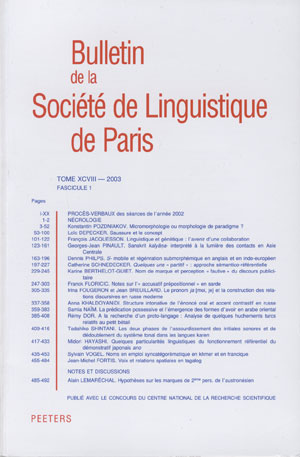 previous article in this issue previous article in this issue | next article in this issue  |

Preview first page |
Document Details : Title: Be+ing Subtitle: Opérateur de rhématisation en anglais oral spontané? Author(s): GAUDY-CAMPBELL, Isabelle Journal: Bulletin de la Société de Linguistique de Paris Volume: 106 Issue: 1 Date: 2011 Pages: 343-356 DOI: 10.2143/BSL.106.1.2141874 Abstract : Cette étude s’inscrit dans le cadre de l’analyse de l’anglais oral spontané. Nous nous intéressons plus particulièrement aux temps de construction du discours et aux modes d’enchaînement des propos. Si l’on considère les paragraphes oraux selon un axe syntaxique, on remarque que l’aspect be+ing apparaît le plus fréquemment dans le rhème de l’énoncé. Or, cet opérateur a été abondamment étudié dans le cadre de la linguistique anglaise et explicité comme opérateur thématique et opérateur d’anaphore. Confronté au comportement de l’opérateur dans la spontanéité de son usage, serait-on en contradiction avec des acquis théoriques? Notre propos est alors de résorber cette apparente contradiction en revenant sur les enjeux inhérents à la répartition syntaxique des énoncés oraux et en analysant des enchaînements authentiques à l’interface de l’analyse syntaxique et de la linguistique métaopérationnelle. In this article we look at spontaneous speech in English and, more particularly, at the different stages and ways of constructing speech. If we consider oral utterances syntactically, we observe that the be+ing aspect often arises in the rheme. However, this operator has been very much studied in English linguistics as a thematic and anaphoric operator. Given the behaviour of the operator in spontaneous speech, could we be in contradiction with existing theory? We set out to cancel this apparent contradiction by revisiting what is at stake in the syntactic structure of oral utterances and by analysing authentic speech progress at the interface between syntactic analysis and metaoperational linguistics. In dieser Arbeit geht es darum, das spontan gesprochene Englisch und insbesondere die verschiedenen Etappen und Modalitäten des Redeablaufs unter die Lupe zu nehmen. Untersuchen wir mündliche Äußerungen auf ihre Synthax hin, so sehen wir, dass die Form be+ing oft in dem Rhema erscheint. Dieser Operator ist bisher vorwiegend als thematischer und anaphorischer Operator untersucht geworden. Stehen wir im Widerspruch zu bestehenden Theorien, wenn wir das Verhalten des Operators in spontaner Sprache analysieren? Unser Ziel ist es, diesen scheinbaren Widerspruch zu überwinden, indem wir das Problem der syntaktischen Struktur in mündlichen Äußerungen wieder aufgreifen und Redeabläufe in authentischer Sprache an der Nahtstelle zwischen der syntaktischen Analyse und der metaoperationellen Linguistik analysieren. |
|


